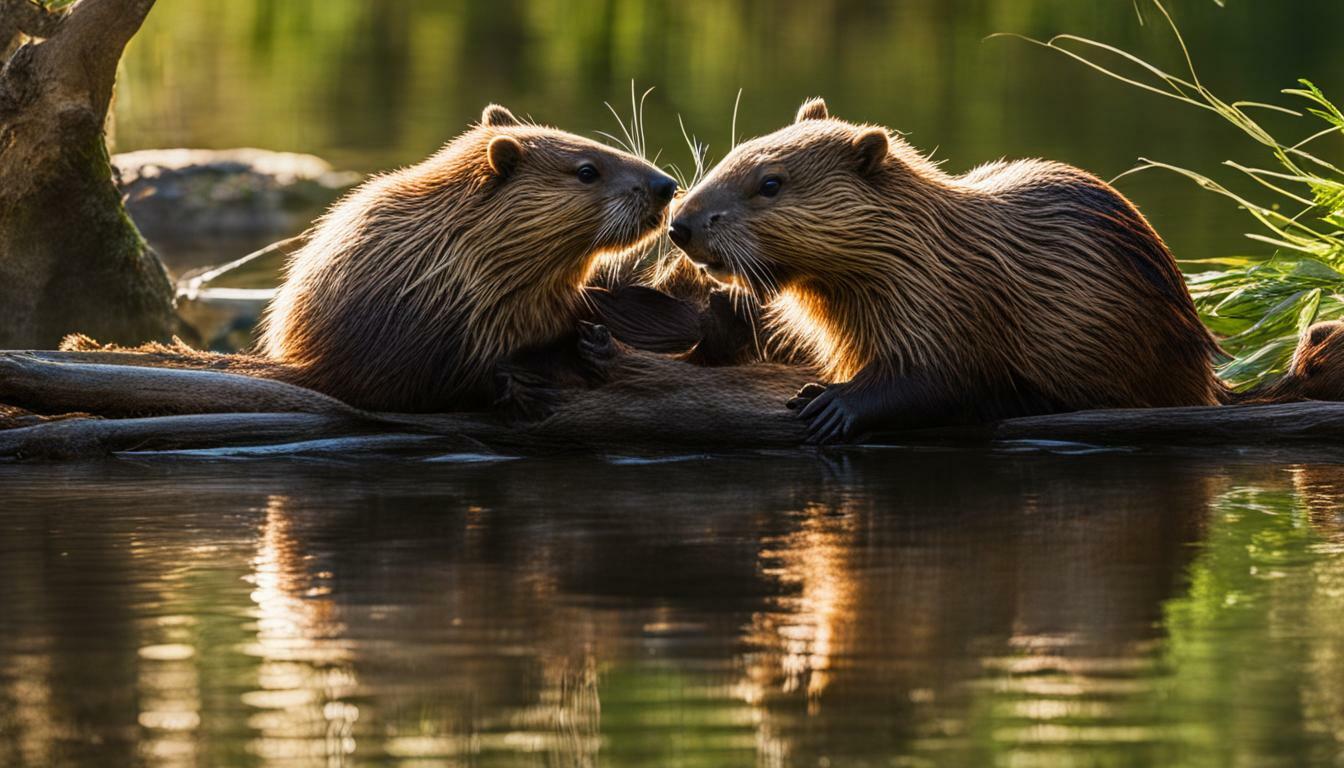Beavers are known for their impressive dam-building skills and their close-knit family dynamics. But do these fascinating creatures mate for life?
Let’s explore their mating habits and breeding behavior to uncover the truth.
Key Takeaways:
- Beavers are one of the rare mammal species that mate for life.
- They live in colonies and raise their children together.
- If one of the beavers dies, the surviving beaver will seek out another mate.
- Mating for life is more about practicality for beavers, as they use their paired bond to build and maintain their colonies.
- Beavers also expand wetlands through their dam building, which has benefits such as filtering toxins from water and supporting biodiversity.
Beaver Courtship and Reproduction
Before beavers form lifelong partnerships, they engage in courtship behaviors to establish a strong bond.
Courtship rituals play a crucial role in beaver reproduction, allowing potential mates to assess each other’s suitability. These behaviors include scent marking, vocalizations, and physical displays.
During courtship, beavers communicate through a variety of sounds, such as soft whining, grunting, and tail slapping on the water.
These vocalizations help them attract a mate and express their willingness to engage in reproductive activities.
Scent marking, achieved through the secretion of castoreum, is another important courtship behavior that allows beavers to establish territorial boundaries and communicate their availability for mating.
Once a strong bond is established, beavers engage in copulation, which typically occurs in water. Mating lasts for a brief period of time, after which the female beaver becomes pregnant.
The gestation period lasts approximately three months, after which the female gives birth to a litter of kits.
Beaver Reproduction: Mate Fidelity in Beavers
Mate fidelity is a significant aspect of beaver reproduction. In most cases, once beavers choose a partner, they stay together for life.
However, if one of the beavers dies, the surviving beaver will seek out another mate to ensure the continuity of the colony.
This behavior highlights the practicality of lifelong partnerships for beavers, as they rely on their strong bonds to build and maintain their colonies.
Beavers’ ability to form lifelong partnerships is rare among mammals. Monogamy provides several advantages for beavers, including shared parental responsibilities, increased protection against predators, and the division of labor in tasks such as dam building and territory defense.
By working together, beaver pairs can create stable environments for their offspring and increase the chances of survival for their entire colony.
| Key Points: |
|---|
| Beavers engage in courtship behaviors to establish a strong bond before forming lifelong partnerships. |
| Courtship rituals include vocalizations, scent marking, and physical displays. |
| Beavers exhibit mate fidelity, staying together for life in most cases. |
| If one beaver dies, the surviving beaver seeks another mate to ensure colony continuity. |
| Lifelong partnerships provide advantages such as shared parental responsibilities and increased colony survival. |
Monogamous Beaver Relationships
Beavers are one of the few mammal species that exhibit monogamous relationships, forming strong bonds with their chosen partner.
They mate for life and live in colonies, where they work together to raise their young. If one of the beavers dies, the surviving beaver will seek out a new mate to continue their partnership.
Mating for life is more than just a romantic gesture for beavers; it serves a practical purpose. Their strong bond enables them to build and maintain their colonies effectively.
Each beaver plays a crucial role in their family dynamics, from constructing elaborate dams to creating secure lodge structures.
Moreover, beavers’ monogamous behavior has significant environmental benefits. Through their dam-building activities, they contribute to the expansion of wetlands.
These wetlands serve as important ecosystems, filtering toxins from water, supporting biodiversity, and providing habitats for various plant and animal species.
Wetland Expansion and Benefits
| Benefits of Beaver Dams | |
|---|---|
| 1. Water Filtration | Beaver dams help trap sediment and filter toxins, improving water quality. |
| 2. Biodiversity Support | Wetlands created by beaver dams provide habitats for a wide range of plant and animal species. |
| 3. Flood Prevention | Beaver dams help regulate water flow, reducing the risk of downstream flooding. |
| 4. Carbon Storage | Wetlands act as carbon sinks, absorbing and storing carbon dioxide from the atmosphere. |
While monogamy is relatively rare among mammals, beavers serve as an extraordinary example of species that exhibit lifelong partnerships.
Their commitment to their chosen mate not only contributes to the success of their colonies but also promotes the growth and preservation of vital ecosystems.
Building and Maintaining Colonies
The strong bond between beaver mates is crucial for the construction and maintenance of their colonies.
Beavers, one of the rare mammal species that mate for life, work together to create elaborate structures that serve as their homes and provide protection from predators.
Within a beaver colony, each partner has specific roles and responsibilities. The male beaver, known as the “boar,” is primarily responsible for constructing the dam.
These dams are built by interweaving branches, twigs, and logs, reinforced with mud and rocks. The meticulous construction of the dam helps create a water barrier, allowing beavers to create a habitat suitable for their needs.
The female beaver, known as the “sow,” focuses on building the lodge. These lodges are large, dome-shaped structures built using sticks and mud.
They serve as a safe haven for the beavers, providing warmth and protection. The entrances to these lodges are cleverly designed underwater, making it difficult for predators to access.
| Beaver Family Dynamics | Beaver Colony Construction |
|---|---|
| Beavers live in family units called colonies, which consist of the mating pair and their offspring. | The strong bond between beaver mates is crucial for the construction and maintenance of their colonies. |
| Both male and female beavers actively participate in the construction process, using their sharp teeth and powerful jaws to cut down trees and shape the landscape. | The boar’s primary responsibility is to build the dam, while the sow focuses on building the lodge. |
| The construction of these colonies helps create complex wetland ecosystems, which support a diverse range of species. | The intricate construction of dams and lodges helps create a habitat suitable for the beavers’ needs, providing warmth, protection, and a stable water source. |
The collaborative effort of both the boar and the sow showcases the importance of their paired bond. The beavers’ ability to work together in constructing and maintaining their colonies exemplifies their unique family dynamics and their commitment to ensuring the survival and well-being of their offspring.
Survival and Repopulation
Beavers’ mating for life is a survival strategy that ensures the continuity of their species and the growth of their population.
These monogamous mammals form strong pair bonds, which play a crucial role in their ability to thrive in their habitats.
By mating for life, beavers establish a stable foundation for their colonies, allowing them to collectively build and maintain their environments.
Their lifelong partnerships enable them to construct intricate dams and lodges, creating habitats that support not only themselves but a diverse range of other species as well.
The survival strategies of beavers extend beyond their physical structures. Through their dam-building activities, they expand wetlands, which brings significant benefits to the ecosystem.
Wetlands help filter toxins from water, improve water quality, and provide habitats for numerous plant and animal species.
The Impact on Beaver Population Growth
Beavers’ monogamous behavior contributes to the growth of their population. By staying with one mate, they ensure a stable environment for their offspring.
Both parents actively participate in raising their young, teaching them essential skills and passing on their knowledge from one generation to the next.
As their population increases, beavers play a vital role in shaping their habitats. Their dam-building activities create ponds and wetlands, attracting more beavers and other wildlife, which further enhances the biodiversity and ecological balance of the area.
| Benefits of Beavers’ Mating for Life |
|---|
| Stable foundation for colony construction and maintenance |
| Expansion of wetlands, supporting biodiversity |
| Improved water quality through toxin filtration |
| Collective parenting and passing on of knowledge |
| Growth of beaver population and ecological impact |
Beavers’ mating for life demonstrates their remarkable ability to adapt to their environment and ensure the long-term survival of their species.
By forming lifelong partnerships and actively shaping their habitats, they create a legacy that extends far beyond their own lifetimes.
Wetland Expansion and Benefits
Beavers’ natural instinct to build dams not only creates habitats for themselves but also leads to the expansion of wetlands with various ecological advantages.
These industrious mammals play a significant role in shaping the landscape and promoting biodiversity in their ecosystems.
By constructing dams across waterways, beavers create impoundments that trap sediment and slow down the flow of water.
This results in the formation of wetlands, which serve as vital habitats for a wide range of plant and animal species.
Wetlands offer shelter, nesting grounds, and abundant food sources, supporting diverse aquatic and terrestrial life.
The expansion of wetlands facilitated by beavers’ dam-building activities also brings numerous environmental benefits.
Wetlands act as natural sponges, absorbing excess water during heavy rainfall and reducing the risk of floods downstream.
They help purify water by trapping pollutants and filtering out sediments, improving water quality and protecting downstream ecosystems.
Additionally, wetlands contribute to carbon sequestration, storing significant amounts of carbon dioxide and mitigating the effects of climate change.
Furthermore, these created wetlands become vibrant ecosystems teeming with biodiversity. They provide habitat for a variety of species, including amphibians, birds, fish, and mammals.
They support the growth of aquatic plants, which in turn attract insects and other invertebrates, forming the base of the food chain.
The presence of wetlands created by beavers enhances the overall ecological health and resilience of the surrounding landscape.
Table: Beaver Wetland Expansion and Benefits
| Advantages of Beaver Wetland Expansion | Examples |
|---|---|
| Enhanced biodiversity | Increased populations of amphibians, birds, and fish |
| Improved water quality | Trapping of sediments and pollutants |
| Flood prevention | Reduced downstream flooding during heavy rainfall |
| Climate change mitigation | Carbon sequestration and storage |
By understanding and appreciating the importance of beavers’ contributions, we can work towards conserving and protecting these remarkable creatures and the valuable wetlands they create.
Lifelong Bonding and Colony Success
The lifelong bond between beaver mates plays a vital role in the success and longevity of their colonies.
Beavers are one of the rare mammal species that mate for life, forming a strong partnership that lasts until one of them passes away.
This bond is crucial for their collective survival and the well-being of their offspring.
When it comes to building and maintaining their colonies, the beavers work together as a team. They use their paired bond to construct intricate dams and lodges, creating a safe and suitable habitat for their family.
Each partner contributes their skills and expertise, ensuring the colony’s survival and protection.
Through their dam-building activities, beavers also play a vital role in wetland expansion. These dams help regulate water flow, filter toxins, and support a diverse range of plant and animal species.
The beavers’ lifelong bonding enhances their efficiency in building and maintaining these essential structures, ultimately benefiting not only their own colony but also the surrounding ecosystem.
| Benefits of Beaver Colony Success |
|---|
| Protection from predators |
| Enhanced habitat for other wildlife |
| Regulation of water flow |
| Improved water quality |
| Expansion of wetlands |
The success of a beaver colony relies on the lifelong bonding between mates. Through their unwavering commitment to each other, beavers create a harmonious and efficient system that supports their survival and contributes to the overall health of their environment.
Their monogamous behavior is a testament to the unique social dynamics and adaptability of these incredible creatures.
Coping with Loss and Seeking New Mates
When a beaver loses its mate, it displays remarkable resilience and actively seeks out a new partner to maintain the social structure within the colony.
Mating for life is a key aspect of beaver behavior, but they are adaptable and can form new partnerships when necessary.
Beavers are highly social animals that rely on pair bonds to construct and maintain their colonies. The loss of a mate can have significant impacts on the dynamics within the colony, as each beaver plays a vital role in the construction of dams and lodges, as well as in the care of their young.
However, beavers do not remain alone for long. They have a strong drive to find a new mate and establish a new pair bond.
This ensures the continuation of their colony and allows them to carry on with their vital ecological role.
By seeking out a new partner, beavers can maintain the stability and functionality of their social structure.
| Beaver Mate Loss | Beaver Seeking New Mates |
|---|---|
| When a beaver loses its mate, it displays remarkable resilience | Beavers actively seek out a new partner to maintain the social structure within the colony |
| Mating for life is a key aspect of beaver behavior | Beavers are adaptable and can form new partnerships when necessary |
| The loss of a mate can have significant impacts on the dynamics within the colony | Beavers have a strong drive to find a new mate and establish a new pair bond |
Beavers are a testament to the resilience and adaptability of nature. Their ability to cope with loss and seek new mates ensures the survival and success of their colonies.
By forming lifelong partnerships and maintaining social structures, beavers contribute to the overall well-being of their species and the ecosystems they inhabit.
Beavers as Monogamous Mammals
While monogamy is rare among mammals, beavers stand out as an example of a species that forms lifelong partnerships.
These remarkable creatures mate for life, demonstrating a level of fidelity that is uncommon in the animal kingdom.
Living in colonies, beavers work together to raise their young and ensure the survival and success of their communities.
If one beaver in a pair passes away, the surviving beaver will actively seek out a new mate, highlighting the importance of bonding within the species.
This behavior is not driven by emotional attachment but rather practicality. Beavers utilize their paired bond to build and maintain their colonies, with each partner playing a significant role in the construction and upkeep of their habitat.
Beavers’ dam-building activities also contribute to the expansion of wetlands, offering numerous benefits to the surrounding environment.
Their dams filter toxins from water, improve water quality, and provide habitats for a diverse range of aquatic species.
This ability to create and sustain wetlands showcases the positive impact these monogamous mammals have on their ecosystems.
The Rarity of Monogamy in Mammals
Monogamy is a rare trait among mammals, with only a select few species forming lifelong partnerships. Beavers are a prime example of one such species.
By studying their mating behavior and social dynamics, scientists gain valuable insights into the complexities of monogamy in the animal kingdom.
Understanding these relationships can shed light on the evolutionary significance of monogamy and its role in species survival.
| Key Points | Summary |
|---|---|
| Beavers mate for life | Highlighting their lifelong partnerships |
| They live in colonies | Working together to raise their young |
| Beavers actively seek new mates if one dies | Emphasizing the importance of bonding |
| Their paired bond helps build and maintain colonies | Showcasing the practicality of their monogamous behavior |
| Dam-building contributes to wetland expansion | Providing numerous benefits to the environment |
| Monogamy is rare among mammals | Beavers as an example of a species that forms lifelong partnerships |
Conclusion
The mating habits of beavers, characterized by lifelong partnerships, play a crucial role in their social structure, colony success, and the expansion of wetlands.
Beavers are one of the rare mammal species that mate for life. They live in colonies, working together to build and maintain their dams and lodges.
This lifelong commitment ensures a stable environment for raising their young and thriving as a community.
If one of the beavers in a pair dies, the surviving beaver will actively seek out a new mate to maintain the stability and functionality of the colony.
This demonstrates the practicality of their lifelong partnerships, as they understand the importance of having a reliable partner to support their shared responsibilities.
Not only do beavers contribute to the overall well-being of their colonies, but they also have a significant impact on the environment.
Through their dam-building activities, beavers expand wetlands, creating habitats for diverse plant and animal species.
These wetlands provide numerous benefits, such as filtering toxins from water, mitigating floods, and supporting biodiversity.
Monogamy is rare among mammals, making beavers a fascinating exception. Their lifelong partnerships showcase the unique nature of beaver behavior and their ability to thrive in social structures that prioritize mutual support and cooperation.
FAQ
Do beavers mate for life?
Yes, beavers are one of the rare mammal species that mate for life.
What is the purpose of beaver mating for life?
Mating for life is more about practicality for beavers, as they use their paired bond to build and maintain their colonies.
What happens if one of the beavers dies?
If one of the beavers dies, the surviving beaver will seek out another mate.
How do beavers expand wetlands?
Beavers expand wetlands through their dam building, which has benefits such as filtering toxins from water and supporting biodiversity.
Are there any other mammals that mate for life?
While monogamy is rare among mammals, beavers are an example of a species that exhibits lifelong partnerships.




